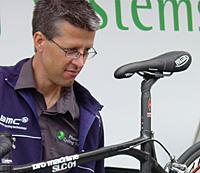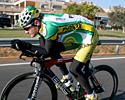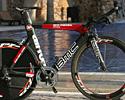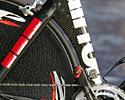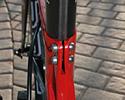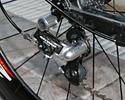
Recently on Cyclingnews.com |
Tech interview: BMC chief engineer Rolf Singenberger, July 6, 2006, part oneThe man behind Floyd's flyerFloyd Landis hasn't yet shown himself at this Tour de France, but earlier in the year, the Phonak team leader proved he was a force to be reckoned with by winning the Tour of California, Tour de Georgia and Paris-Nice. At Georgia and California, Landis time-trialling ability was crucial to his victory as he demolished all opposition against the clock. Shane Stokes meets the creator of Landis' bikes, BMC chief engineer Rolf Singenberger.
Floyd Landis is very happy with his BMC time trial bike. "We have the best TT bikes. For sure," he told Cyclingnews earlier this season. "The engineers have spent the most time on them, they are the lightest. Nobody else has a bike like ours." BMC chief engineer Rolf Singenberger echoes Landis' claim that the Phonak TT bikes are as light as is allowed. According to him, the bike is at the UCI weight limit of 6.8 kilos, even with full rear disk and deep section front wheels. Singenberger says BMC's frames owe their light weight and stiffness the Carbon Nano Technology (CNT) material developed by Easton and used throughout the Pro Machine SLC01 road frame.
The thinking behind the CNT material is that the weakest areas in traditional carbon fibre components are the resin-filled gaps between the fibres themselves. In order to overcome this, Easton has developed what the company calls an "Enhanced Resin System" using carbon nanotubes (CNT) mixed with the resin to strengthen the material. As the name suggests, carbon nanotubes are extremely small tubes, just one billionth of a meter in diameter, made from a lattice of carbon atoms. This is a material that has structural engineers salivating because of its incredible strength-to-weight ratio: many times greater than steel. It also has them frustrated because making nanotubes long enough to replace the fibres in carbon fibre composites is proving frustratingly difficult. But they're still useful as a reinforcement in the resin matrix of a conventional carbon composite. Through the impregnation of the resin/fibre matrix with evenly-distributed carbon nanotubes, Easton has been able to construct a material which is tougher and stiffer than regular carbon fibre. This means that frames can be made considerably lighter with no loss of rigidity. As a result of this process, Singenberger says that this year's Pro Machine road frame is almost 300 grams lighter than the previous Team Machine SLT 01 model. This weight saving is due in part to the CNT technology and also because the old aluminium lugs have been completely done away with, the new frame being entirely made from carbon. Even the headset support surfaces and dropouts are made from this material, and because none of these parts have to be machined after production, strength is further enhanced. In fact, the only aluminium used is the necessary threading in the bottom bracket.
We sat down with Singenberger to get more details of the new bikes that Landis and Phonak have campaigned successfully already this year and that will be carrying the team's hopes for Tour de France glory. Cyclingnews: What changes have been made from last year's bikes? Rolf Singenberger: Well, the paintjob is probably the first thing you will notice. Last autumn we were unsure as to who would be the main sponsors of the team, so we weren't certain what colours the clothing would be in 2006. Time was passing and so we were told that we could do up the new bikes in whatever colours we wanted. We went for red, black and white, which are more Swiss. I think it looks well. Secondly, last year we had alloy lugs forged with carbon tubes, which gave it a distinctive look around this area (points to seat/top tube cluster). Of course, the fashion is carbon and also to have the frames as light as possible, so we decided that we wanted to go beneath 1 kg. We have now made a 960 g frame, and this is possible only with full carbon.
I think the biggest difference is actually something other than the aesthetics, though. The big thing for us was to find the right source, the right partner. As you know, we are quite close to Easton - they are one of our sponsors. Easton has developed the CNT technology, the carbon nano-tubes, which is a unique technology. What this involves is that they have carbon tubes in the resin system; we are talking about something on the molecular level, billionths of a metre. It is a chemical treatment. CN: So how does it work? RS: It is pre-preg carbon…you have the fibres and you need the glue to hold them together. So you have is a sheet of carbon fibre, what you call pre-preg…it is pre-impregnated with resin. 60 percent is fibre and 40 percent is resin. In this resin, we increased the stiffness up by 20 percent. So is a kind of revolution with carbon. It means the whole frame can be lighter, or it can be stiffer for the same weight. CN: Can you tell me about the partnership with Easton? RS: Easton provide us with the technology and we then do the whole engineering of the frame, the design and the testing. This is why we mention Easton technology on the frame [decals]. It is a kind of common venture with them, we share this technology. We teach each other - they learn about frame making and we learn how to use this technology. CN: What is really noticeable is just how shaped the tubes are. Traditionally, carbon frames tended to have round tubes but now that is changing.
RS: That is part of our identity, these kind of shapes. You can see that with all our products. You can see the very pronounced T shape profile of the top tube, the different shape of the down tube. When it is heading towards the bottom bracket it increases in size - we use the whole width of the BB to increase stiffness. You can see that we really go right to the edge to increase stiffness. The chainstays are the same idea. They are oversized and shaped in a certain way to be stiffer. The idea is to have the stiffest frame possible for this particular weight. CN: What is the thinking behind the T-shape cross section of the top-tube? RS: That is very easy to understand. You have lateral load acting on the frame, and you have load from the front. So this is to prevent bending in the top tube. CN: You have a very unique seat cluster area. Where does that design come from?
RS: I think you have to look at the previous alloy construction to understand the evolution. In the beginning, we wanted to have the one-piece connection between these three tubes. It was easier for alignment and stiffer. We also wanted to have another clamp acting on the seatpost…in the past there were a lot of problems with broken carbon seatposts. It was not actually the seatpost that was the problem, it was the frame and the way pressure was applied. With a regular clamp, it clamps along a line, along one small area. For carbon, this is not a good idea. But now, the two bolts clamp along a greater area, so there is a greater contact area, we need to tighten it less and it is very safe for the carbon seatpost. There is a much longer life in the post as a result. That is the evolution of that part of the frame. We tried to keep the same identity, as regards the shape. I think this is one of the few bikes where you can take off the paintwork and the transfers but you still know which frame it is. Now there is so much mainstream in the pro carbon stuff, it is really important to have your own ideas. That area is all one-piece. It is actually easier to design with carbon fibre, to follow the shape, than it is when doing it with metal. The unique thing on this frame is that there is no machining at all, after bonding. This frame is bonded with several pieces together, several monocoque pieces. There is no machining, it is all in the moulds. It is quite expensive, but with the new seat post area, the dropouts, even the internal cable routing - there is no machining at all. There is no machining in the headset area, either. It is shaped, so you don't cut the fibre. The only alloy part on the whole frame is the bottom bracket thread. All the rest is full carbon, including the dropout and including the bearing surface [for the headset]. You can make it stronger than alloy. CN: So what is the weight difference between last year's frame and this year's frame? RS: It is close to 300 grams, about 250. The stiffness is similar. The riders like it, and when you do the stiffest test, the figures are different - a lugged frame has different characteristics than a full carbon frame. But in terms of overall stiffness, we are very close. CN: What about the components - is there any major changes to last year?
RS: No, we will continue with the same. Easton are one of our main sponsors, and we are still using Campagnolo. We have DT Swiss hubs and spokes, with Zipp rims. Continental tyres, Speedplay pedals, Selle Italia saddles. CN: You say that you have saved almost 300 grams on the frame; what weight then does that give you then? RS: It is 960 grams for the medium sized frame. CN: And how about the complete bike? RS: Well, last year at the Tour, we had four riders using the new bike. Perhaps you saw it, it was completely black with white stickers. We were far below the UCI limit, so we had to add weight to it. Our light bike is 6.2, 6.3 kilos. Then, for example, Floyd used the Cycle Ops [PowerTap] hub for the whole tour, which added another 300 grams to the bike. He also used alloy cranks and stuff like that to bring it up. In part two, Singenberger discusses the UCI weight limit, customising carbon and the future of BMC. PhotographyFor a thumbnail gallery of these images, click here Images by Andy Kessler/BMC
Images by Shane Stokes/Cyclingnews
|

